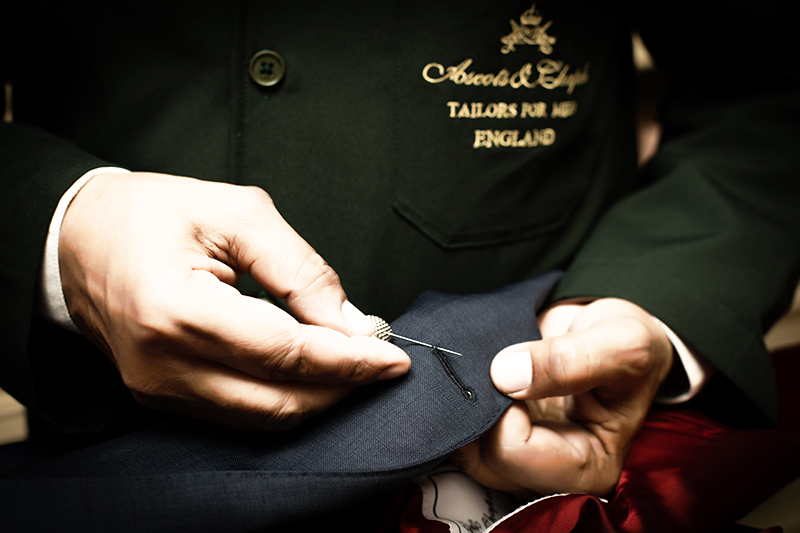
“I am not a couturier, I am a craftsman, a creator of happiness” Yves Saint Laurent
Paris might be the home of haute couture, but the heart and soul of bespoke menswear is undeniably British. Nowhere else is as synonymous with the heritage, craftsmanship and character of true tailoring.
And gents, when I say bespoke, I’m not just talking about a good suit.
The word bespoke comes from “bespeak”, an Old English term meaning “to speak for” or “to arrange”. So, put simply, bespoke means to have a conversation. It’s not a one-way process, it’s a dialogue. And when it comes to that exchange, the British arguably do it better than anyone.
So, how did we get here? And why, in an age of fast fashion and digital everything, does British bespoke still reign supreme?
Let’s rewind several centuries to explore the story of bespoke: how it started, how it evolved and why British bespoke is still the benchmark.
The birth of bespoke
The concept of tailoring has technically existed since the Middle Ages. The term “tailor” first appeared in English in 1297, thought to have derived from the French tailler, meaning “to cut”. But these early “tailors” were primarily focused on function not fashion – that is, keeping warm, dry and appropriately covered.
It wasn’t until the Renaissance that the concept of fashion, at least as we understand it, emerged. This cultural and economic revival embraced art, commerce and innovation, giving rise to a wealthy class of nobles and merchants who invested heavily in luxurious textiles such as silks, velvets and fine wools, as well the latest advancement in weaving, dyeing and garment construction.
In 17th-century England, these continental influences started to take root. London, in particular, became a centre of sartorial refinement, boosted by the arrival of Huguenot refugees who brought with them exceptional skills in textile production and tailoring.
By the late 1600s, the origins of bespoke tailoring had emerged, although the practice remained largely informal and reserved for the elite. It would take another century – and the rise of Savile Row and dedicated tailoring houses – for British bespoke to become the craft it is known as today.

Evolution through the centuries
Savile Row was born in the 1730s. Laid out as part of the Burlington Estate and named by the 3rd Earl of Burlington after his wife, Lady Dorothy Savile, the street quickly became a fashionable destination for the upper crust of society, who were drawn to its Mayfair location.
By the late 18th and early 19th century, tailors were setting up shop in and around the area, establishing the foundation of what would soon become synonymous with British bespoke. It was during this period, in Regency England, that the modern men’s suit was born. Beau Brummel, the English dandy who rejected fussy fashions in favour of clean lines, understated elegance and meticulous detail is widely credited with popularising many of the conventions of classic menswear, including the suit.
The 19th century is often referred to as the golden age of British tailoring, with Savile Row firmly at the epicentre. Legendary houses like Henry Poole & Co., Gieves & Hawkes and Anderson & Sheppard emerged during this period, catering to royalty, military officers, politicians and ambassadors.
In fact, such was the fame of Savile Row, that the Japanese word for suit even to this day is ‘Sabiro’, a nod to the renowned street’s name.
Even after the upheavals of two world wars, Savile Row remained the home of bespoke, attracting a new generation of designers. Names like Hardy Amies and Tommy Nutter, who dressed Mick and Bianca Jagger for their wedding in the ‘60s, brought fresh flair to the craft.
By the mid-20th century, the influence of British bespoke extended beyond the borders of Savile Row. Traditional tailoring houses continue to thrive across the UK and beyond, while newer designers defined what bespoke could mean. For instance, innovations such as remote and 3D fittings have made bespoke more accessible, proving that while the craft has evolved, the core principles of British tailoring remain steadfast.

Principles of British bespoke
Today, British bespoke is more than a tradition, it’s a living and evolving practice that continues to set the standard worldwide.
So, what are the principles of British bespoke?
- Conversation. A true bespoke experience is about more than measurements, it’s a dialogue. The experience begins with questions beyond your tastes and requirements to explore your life, habits and work. This helps translate lifestyle into a garment designed to function as well as it looks.
- Observations. Good tailors quietly observe. They watch how you stand, how your shoulders relax, how your body naturally leans or moves. These are the kinds of subtleties that can’t be captured by numbers alone.
- Handcraftmanship. Skill is at the heart of British bespoke. Every piece is crafted from a unique paper pattern and hours of hand stitching. British bespoke encompasses techniques like full canvassing and pad stitching.
- Multiple fittings. From baste to final fitting, you can expect at least three (but often more) appointments to perfect every detail.
- High-quality textiles. Fabric is the foundation of any good suit. British bespoke tailors work with the finest clothes sourced from reputable mills, ranging from featherweight flannels to luxurious cashmere.
- Attention to detail. No detail is too small in British bespoke, from the drape of the sleeve to the placement of a pocket.
Why British bespoke remains the gold standard
British bespoke isn’t just about suits – it’s about craft, character and care. Rooted in centuries of tradition, British bespoke tailoring is built on meticulous handcraft, attention to detail and a deep understanding of fabric and fit. This reputation for excellence has been earned through centuries of refinement, influencing formalwear across the globe.
The appeal is timeless. From royalty and world leaders to cultural icons and Hollywood stars, those who wear British bespoke understand that they are investing in more than clothes – they’re investing in heritage, precision and character.
Tailoring the future
British bespoke is enduring because it values depth over speed, and substance over surface. In a world of fleeting trends and off-the-peg style, bespoke tailoring is a testament to patience, experience and connection. In the changing tides of fashion, British bespoke continues to set the standard, quietly and confidently.
So, if you’re after a truly bespoke British suit, gents, why not step into Ascots & Chapels? Get in touch to book an appointment and discover the art of good tailoring.
Author: Gary Sweeney
